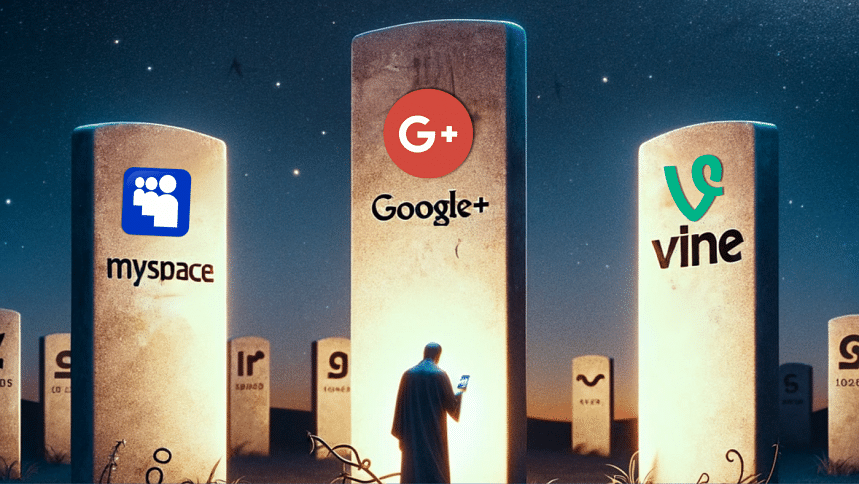MySpace, Google+, Vine: How did they die?

Remember MySpace, every 90s kid's first introduction to a global social media website? Or Google+, the reputed tech giant's failed attempt at mimicking Facebook? You also probably remember Vine, the spiritual ancestor of everyone's favourite, TikTok.
In the ever-evolving world of technology, some social media platforms can feel like shooting stars—bright, attention-grabbing, but fleeting. While many popular social media sites have been able to retain their initial boom in popularity for years to come, there are the unfortunate ones that got lost in the waves of modern innovation and user engagement.
Let's take a look at three once-popular social platforms that have died over the years: MySpace, Google+, and Vine, and find out what led to their untimely demise.
MySpace: Say hi to Tom!
Founded in August 2003 by Tom Anderson (everyone's first friend on MySpace) and Chris DeWolfe, MySpace was one of the earliest social networking platforms. Similar to what Facebook is known for now, MySpace was the go-to place to connect with people online, share content, or publish blogs using personalised profiles.
MySpace users with HTML and CSS know-how could freely edit their profiles to create personally crafted, visually engaging profiles. Older users will also remember the iconic 'Top 8 Friends' feature, which allowed users to display their eight closest friends on their profile page - a source of everyday drama in friend circles back then. Many independent artists used MySpace as a promotional tool, and some successful musicians today credit MySpace with helping them gain early exposure.
MySpace experienced explosive growth in its early years. By 2006, it was the most popular social networking site in the world, surpassing even Google in terms of website visits. However, as the late 2000s rolled around, MySpace faced a fierce competitor: Facebook. The brand-new social media platform offered a cleaner interface, better privacy controls, and a focus on connecting with real-life friends, attracting a large user base that steadily flocked away from MySpace.
In 2011, MySpace was sold to the digital advertising company Specific Media and a group of investors that included, of all people, Justin Timberlake. Timberlake, along with the new owners, sought to revive the once-dominant social networking platform, relaunching it to include a redesigned interface, a discovery engine for music, and mobile support. However, despite the best of their efforts, MySpace struggled to regain the relevance it once had and remained forever lost in time.
Google+: The 'plus one' for your Google account
Nowadays, almost anyone who uses the internet has a Google/Gmail account. The ubiquitous tech giant has more than made its place as the dominant search engine in the market, being used as a cornerstone tool in many online businesses and websites. While all big companies have their fair share of failures, Google's attempt to mimic Facebook is a particularly noteworthy dark time in the tech giant's otherwise rich history.
Officially launched in June 2011, Google+ (Google Plus) was Google's very own social networking platform. It was designed to be a competitor to other social media platforms like Facebook and Twitter, offering a range of features aimed at facilitating social connections, content sharing, and online interactions.
Some of the most notable features of Google+ included Circles, with which users could personally organise their connections into different groups; Hangouts, the video chat platform for socialising and collaboration; and Communities, which allowed users to join or create groups based on shared interests. Similar to the 'Like' button on Facebook, Google+ also had a '+1' button for showing public approval of a post or content.
Intended to create a cohesive online experience for users, Google+ could be used alongside various other Google services, including Gmail, YouTube, and Google Photos. However, despite its ambitious features and wide integration support, the platform struggled to gain the same level of popularity as competing social media platforms. Users found it challenging to move away from established platforms like Facebook, and Google+ faced criticism for issues related to user engagement, user interface, and privacy concerns.
In October 2018, Google announced that it would be shutting down Google+ for consumers due in part to a data breach that exposed user information. The consumer version of Google+ was officially discontinued in April 2019. While Google+ as a social media platform did not achieve widespread success, some of its features, such as Hangouts, have persisted in other forms within the Google ecosystem.
Vine: The TikTok before TikTok
Launched in 2013, Vine was a short-form video hosting service that allowed users to create and share six-second looping video clips. What made Vine unique and popular was its emphasis on brevity, encouraging users to be creative within a strict time constraint - quite similar to the premise of one of the most popular apps right now, TikTok.
While short-form content is commonplace nowadays, it was Vine that paved the way for short videos and, subsequently, helped many content creators of the time gain popularity on the internet. The platform provided a gateway to viral fame, launching the careers of many social media influencers who are still relevant today.
Users remember Vine fondly not only because of the innovation it provided but also its straightforward, user-friendly interface. Being simple to use means it was accessible to a wider range of audience, and the app made it easy for anyone to easily create content and share it without needing elaborate production. Its signature video looping format combined with fun tools like stop-motion and time-lapse helped solidify Vine as a platform for creative storytelling for the masses.
However, all good stories must come to an end. Twitter, which owned Vine, eventually started facing financial challenges and supporting Vine became an unaffordable expense. The platform also struggled with monetisation strategies, failing to provide adequate opportunities for content creators to generate revenue. This aspect hindered the platform's ability to attract and retain top talent, who eventually started leaving for greener grounds on Instagram, Snapchat, and YouTube.
In October 2016, Twitter officially announced the discontinuation of the Vine app, losing the competition against fiercer competitors. To this day, loyal Vine fans blame internal management for the platform's downfall. However, despite Vine being dead, its spirit - or the core feature at least - lives on in TikTok.

 For all latest news, follow The Daily Star's Google News channel.
For all latest news, follow The Daily Star's Google News channel. 





Comments